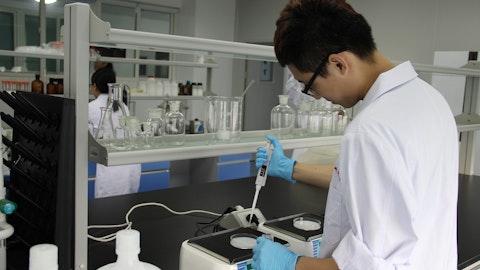T1 Energy Inc (NYSE:TE) Q1 2025 Earnings Call Transcript May 15, 2025
T1 Energy Inc misses on earnings expectations. Reported EPS is $-0.11 EPS, expectations were $-0.07.
Operator: Good day and thank you for standing by. Welcome to the T1 Energy’s First Quarter 2025 Earnings Conference Call. At this time, all participants are in a listen-only mode. After the speakers’ presentation, there will be a question-and-answer session. [Operator Instructions] Please be advised that today’s conference is being recorded. I would now like to turn the conference over to your host today, Jeff Spittel, Executive Vice President of Investor Relations and Corporate Development.
Jeffrey Spittel: Good morning and welcome to T1 Energy’s first quarter 2025 earnings conference call. With me today on the call are Dan Barcelo, our Chief Executive Officer and Chairman of the Board; Evan Calio, our Chief Financial Officer; Jaime Gualy, our Executive Vice President of Corporate Development; Rob Gibbons, our EVP of Strategic Partnerships; Andy Monroe, our Chief Legal and Policy Officer; and Borge Selstad, our SVP of Operations. During today’s call, management may make forward-looking statements about our business. These forward-looking statements involve significant risks and uncertainties that could cause actual results to differ materially from expectations. Most of these factors are outside T1’s control and are difficult to predict.
Additional information about risk factors that could materially affect our business are available in our annual report on Form 10-K filed with the Securities and Exchange Commission and our other filings made with the SEC, all of which are available on the Investor Relations section of our website. With that, I’ll turn the call over to Dan.
Daniel Barcelo: Thanks, Jeff and welcome everyone to our earnings call to review our first full quarter at T1 Energy. The 2 recurring themes for today’s call are progress and policy. The progress refers to T1’s ongoing rapid corporate transformation to realize our mission of building a domestic solar and battery supply chain to invigorate America with scalable, reliable and low-cost energy while we establish pathways to maximize domestic content. But of course, that progress isn’t taking place in a vacuum and the lingering uncertainties around trade policy and the future state of the Inflation Reduction Act are creating some near-term complexity. So let’s start on Slide 4 with an overview of the policy environment and the key considerations for T1.
As you are most likely aware, the House Ways and Means Committee has advanced changes to key IRA energy tax provisions. Our preliminary assessment of the bill is that there are provisions that validate T1’s strategy of investing in advanced manufacturing in the United States, including retention of the 45X Advanced Manufacturing Production Tax Credit and the domestic content bonus. However, we believe there are proposed elements of the bill that will stifle competition, growth, technology onshoring and choices for T1’s developer customers. Given our commercial partnership with Trina, the stringent foreign entity of concern language passed by the Ways and Means Committee has our attention. But we have been neither surprised nor unprepared to consider modifying elements of our business plan, if necessary, to ensure compliance and preserve access to IRA incentives that are enabling T1 to build an integrated U.S. supply chain and to advance our domestic content strategy.
We also have ongoing and productive dialogues with local, state and federal lawmakers to promote T1’s interest and investments in the U.S. solar production industry. We believe that incentives under Section 45X, 48E and 45Y are fundamental to the U.S., building a vibrant, competitive and localized solar value chain and we will continue to tell that story on Capitol Hill and in Texas along with our domestic partners. In the interim, I’ll remind our investors that this is the first step in a long legislative process that will very likely see the language changes as it advances through Congress. We are hopeful that practical modifications to minimize commercial disruption and to support domestic solar energy will be included in subsequent and final versions of the reconciliation bill.
T1 expects to have a strong and influential voice in the discussion of U.S. solar industrial policy given the meaningful investments we have made in domestic manufacturing, American jobs and the initial phases of establishing a U.S. solar value chain. Spearheading this effort will be our new Chief Legal and Policy Officer, Mr. Andy Monroe. Andy brings more than 30 years of legal expertise and has spent the last decade in the U.S. solar sector. While he was at Qcells North America, he was instrumental in shaping the framework of what eventually became Section 45X of the Inflation Reduction Act. Andy, we’re delighted to have you on Board and welcome to the team. Turning to Slide 5 and U.S. trade policy. As we indicated publicly during Q1, T1 is supportive of tariffs that level the competitive playing field for the U.S. solar industry, including anti-dumping and countervailing duties.
These initiatives are intended to reward Tier 1 producers who invest in domestic supply chains like T1. As we have disclosed previously, we are already sourcing the majority of our polysilicon from here in the U.S. and we are executing our plan to build an integrated domestic solar manufacturing footprint. Although we generally support tariffs for the solar industry, like many of our peers, we are contending with some near-term headwinds due to tariff uncertainty. T1 and our developer customers require visibility into bill of materials costs to accurately bid offtake and PPA contracts. In the absence of that visibility to accurately risk assess our pricing, we cannot justify bidding into the current merchant sales market. Accordingly, as Evan will detail shortly, we are revising our 2025 sales production and EBITDA guidance to assume limited merchant sales for 2025 as we wait for market clarity.
With 1.7 gigawatts of committed offtake volumes already in our G1 portfolio for 2025, revenues and operating cash flow will continue to ramp into the second half under these new guidance assumptions and we anticipate exiting 2025 with a robust cash and liquidity position. Near-term uncertainties aside, the fundamentals of the U.S. solar industry remain healthy and supportive of T1’s strategy. Solar and battery storage have emerged as the fastest and most cost-effective technologies to add to U.S. generating capacity. With the emergence of energy-intensive technologies such as AI, the electrification of society and the potential for a U.S. advanced manufacturing renaissance, solar plus storage will remain critical to the all-of-the-above approach that is necessary to satisfy growing U.S. energy demand.
I’ll conclude our commentary on policy by underscoring that T1’s strategy dovetails with several of President Trump’s key priorities. We are focused on the strategic development of critical U.S. energy supply chains, we are at the forefront of bringing advanced manufacturing back to American shores and we are building an American job creation engine. We are resolute in our mission and we are determined to promote our shareholders’ interests and we are making rapid progress to build T1 into U.S. energy powerhouse. With that, let’s turn to Slide 6 for an overview of our key messages. Our rapid global corporate transformation gained momentum in the first quarter and in the weeks that have followed. We have continued to make progress on several fronts.
This morning, we announced that we have signed our first new corporate customer sales agreement as T1 Energy with an emerging developer for 253 megawatts of 2025 module volumes out of G1 Dallas. We’ll hear more about this contract and our commercial development from Rob later in the call. As I indicated previously, we have reduced our 2025 financial and operating guidance lower to account for some of the near-term uncertainties in the market and the elective conversion of 3 G1 production lines to TOPCon technology. Despite the revisions to guidance, T1 has a strong liquidity outlook and position. At the low end of the updated 2025 EBITDA guidance range, T1 is projected to have cash and liquidity of more than $100 million at year-end. Evan will walk you through the moving parts shortly.
From an operational perspective, the ramp-up at G1 Dallas continues to progress smoothly. On April 30, we indicated that T1 had successfully converted the G1 Dallas construction loan to a $235 million term loan following third-party verification that construction, installation and commissioning activities were completed. The plant is fully operational and module deliveries to offtake customers have begun to ramp up. G1 Dallas is a world-class asset and we look forward to showcasing it to investors, customers and other key partners. For those of you who can’t visit G1 in person, be on the lookout for the launch of our expanded website to give you a feel for our operations virtually. Following site selection of Sandow Lakes Ranch in Milam County, Texas in March, we are progressing through the initial stages of project development for G2 Austin, our planned U.S. solar cell facility.
There is meaningful interest in this project and we are engaged in productive capital formation discussions with several potential partners. This morning, we announced the Heads of Agreement with a third-party partner aligned with the Kingdom of Saudi Arabia to explore a potential investment into the G2 project. To be clear, this is a non-binding agreement and we are still in the early stages of raising capital for G2. But so far, we are pleased with the receptivity to investing in T1’s planned U.S. solar cell production manufacturing facility. With sales and deliveries beginning to ramp under our 1.7 gigawatt of combined 2025 customer offtake contracts and sales agreements at G1 Dallas, T1’s cash and liquidity outlook for 2025 remains healthy despite the near-term merchant sales uncertainties.
G1 operating cash flows combined with the wind down of our legacy European organization and reduction of associated costs into 2026 should support our significant liquidity position. As we indicated in our previous call in March, T1 and Trina filed a joint voluntary notice with the Committee on Foreign Investment in the United States and the CFIUS process is ongoing. And finally, we continue to make progress with our European wind-down and portfolio optimization initiatives. As European personnel-related costs roll off of our P&L, the cost savings from the wind-down should accelerate later this year. In conjunction with the wind-down, our Board of Directors is also overseeing the process of potentially harvesting value from our legacy portfolio, including Giga Arctic, the CQP and the Giga Vasa project.
Securing access to additional power for these assets is a key value driver. And as the process develops, we will continue to provide updates to our investors. Moving to Slide 7, we’ll turn our attention to G1 Dallas which has provided the launch pad for T1’s operations and commercial development as a solar equipment manufacturer. Following the handovers to operations in late April, G1 is fully operational and sales are poised to continue ramping with deliveries under our 1.7 gigawatt of 2025 customer offtake contracts and sales agreements. Deliveries under the Trina U.S. offtake started in Q1. And with Q2 underway, we have begun delivering modules to RWE under the 500 megawatt per year sales agreement. We expect to begin shipping modules under the 2025 developer sales agreement that we announced this morning in Q3.
To match production with the temporary lull in bidding activities we are experiencing, we are modifying the 2025 production plan to 2.6 to 3 gigawatts. This change in plans also relates to our decision to convert 3 production lines from PERC to TOPCon technology, demonstrating T1’s responsiveness to customers and operational flexibility. Turning to Slide 8. I’m pleased to report that we are moving forward with initial development of G2 Austin, our planned U.S. solar cell manufacturing facility in Milam County, Texas. As we have documented previously, we believe that G2 Austin is a game changer for T1 competitively and financially. The plant addresses unmet customer demand for U.S. solar cells and modules using TOPCon technology. It represents a major step forward in our domestic content and vertical integration strategies and is expected to be a cash flow engine for T1.
With initial project engineering underway, we have decided to pursue a 2-phase development in equivalent capacity tranches of 2.4 gigawatts each. This development plan should provide T1 with commercial, financial and operational flexibility as we advance our growth strategy. Our project development team led by our Chief Development Officer, Einar Kilde, is executing against this plan and recently launched the tender process with production line equipment vendors. And in parallel, Evan Calio and the finance organization are advancing several capital formation initiatives on parallel tracks. There are no changes to our plan to achieve the start of production at G2 Austin in Q4 2026. And with that, I’ll turn the call over to Evan for a review of T1’s financials.
Evan Calio: Great. Thanks, Dan. Moving to Slide 9. I’ll start with revisions to our financial and operating guidance. On production, we’re lowering and introducing a production range for G1 Dallas of 2.6 gigawatts to 3 gigawatts versus our prior 3.4 guidance — gigawatt guidance. The lower guidance is entirely based upon lower sales due to market uncertainty around tariffs and the integration of Trina’s sales team. The facility is and has been technically capable of running at 5 gigawatts since our April 30 loan conversion. The 2.6 gigawatt production downside reflects our 1.7 gigawatts of contracted sales on a cost-plus basis plus an expected 800 megawatt inventory financing facility that we’re finalizing with Trina for modules that will be produced in 2025 and likely sold in 2026.
This provides potential sales upside for 2026. The 3 gigawatt production upside includes an additional 500 megawatts of merchant sales that could be driven by market clarity and conditions prior to year-end. On EBITDA. We’re reducing our 2025 full year EBITDA guidance to $30 million to $50 million from a prior range of $75 million to $125 million as we match our lower sales outlook, this lower sales outlook of 1.7 gigawatts to 2.3 gigawatts. The range is largely driven by the production level, product mix and our sales initiatives. Since this is a significant revision to EBITDA guidance, I want to provide 4 important points pertaining to our outlook. First, our cash and liquidity position is strong and we expect it will improve as 2025 progresses.
For instance, under the low-end scenario of our EBITDA guidance range, we project cash, liquidity of more than $100 million at year-end 2025 and this includes a payment of $71 million related to our debt and debt services by year-end. Second, we have significant operating leverage. Under the low end of our 2025 EBITDA range, G1 will be producing at only 30% of capacity, 51% lower than our initial guide. At this rate, we generate $25 million of EBITDA, covering our G&A which includes costs associated with the wind down of Europe that roll off in 2026 and allow us to fully service our debt. As we ramp production and sales to full plant capacity, we expect meaningful expansion of T1’s corporate profitability. Third, this is a prudent decision for T1 and our shareholders.
We want to avoid lock-in merchant sales in uncertain material and sub-component cost environment. We won’t bear uncertain tariff risks or lock-in low-price inventory clearing. Fourth, the prize for T1, our customers, our shareholders, our management team are beyond 2025 with the execution of our U.S. vertical integration strategy and domestic content road map. Based upon recent policy proposals just this week and many conversations that we’re having with utility scale developers, demand for domestic content is only increasing. Our ambitions are centered on integrating production from G1 Dallas and G2 Austin as well as other domestic content initiatives. We continue to move forward, as Dan mentioned, on initial developments for G2 Austin, supported by capital formation discussions that we’re having with a variety of potential partners.
Importantly, there are no changes to our target of bringing G2 online by 4Q ’26 nor our annual EBITDA run rate guidance for integrated G1, G2 production of $650 million to $700 million. Turning to Slide 10. Let’s review T1’s financial position. In our first full quarter as T1 Energy, we generated revenue of $64.4 million related to initial deliveries under the Trina cost-plus offtake contract. As we have reported previously, we also successfully converted the G1 Dallas construction loan in late April which was punctuated by handover of all production lines to the operations teams. With production ramping during the quarter, we also continued to build finished goods inventory of solar modules in advance of initial deliveries under the RWE contract which has started in 2Q.
T1 has 500 megawatts of module sales in 2025 associated with the cost-plus RWE contract remaining in 2025. They will take 250 megawatts in the current or second quarter. As you’ll notice, the balance sheet summary table, T1 drew down cash in Q1 2025 which is a trend that we do not expect to persist for the remainder of 2025 as production and sales ramp from G1, so will T1’s operating cash flow which is supported by 1.5 gigawatt of high-margin offtake long-term contracts plus the Cardinal sale that Rob will discuss in a minute. We also expect to begin monetizing Section 45X PTCs in either 2Q or 3Q. And consequently, we have a positive liquidity outlook despite reductions of our EBITDA guidance, as I covered on the prior slide. And now I’d like to introduce Rob Gibbons, our EVP of Strategic Partnerships, to deliver an update on our commercial progress.
Rob?
Rob Gibbons: Thanks, Evan. Let’s turn to Slide 11. The foundation of building a powerful commercial enterprise is in place at T1. The RWE contract structure and client relationship represents the focus of our commercial strategy. We are in advanced discussions with other utilities, IPPs and leading utility scale developers regarding similar contracts. The priorities for these strategic partners include securing TOPCon modules manufactured in the U.S. with U.S. components from a reputable supplier with a traceable supply chain. These are key requirements for our clients to achieve domestic content bonus tax credits. Our announcement of G2 has helped to accelerate existing negotiations and generate additional interest for similar contracts.
As progress on G2 continues and clarity emerges on trade policy, supply chains and the future state of the IRA, we expect to execute additional multiyear take-or-pay module purchase commitments with key U.S. customers. In terms of merchant sales, we announced that T1 has signed a 253 megawatt module sales agreement for 2025 with a utility scale developer for a project in Texas. Deliveries under this contract are expected to begin in Q3 2025 and this contract supports the conversion of 3 of our PERC manufacturing lines to TOPCon to better align with market demand. With 1.7 gigawatt of 2025 module sales in hand for G1 Dallas, T1 will continue to pursue merchant sales opportunities that deliver attractive margins. Moving to Slide 12. Let me provide you with some additional detail about our domestic content road map.
T1’s plan is to establish a vertically integrated U.S. solar supply chain built on domestic content. We will continue to have access to current imported components to maintain flexibility in our supply chain given the evolving policy landscape. Our plan is to produce U.S. modules with more than 70% domestic content by 2027. This strategy is book-ended by our U.S. polysilicon supply contract and our module production facility at G1 Dallas but we intend to establish a domestic supply chain that includes polysilicon, ingots, wafers and cells as well as other bill of material components. There are several strategic and commercial benefits to pursuing this strategy. Not only does it align with the most stringent potential modifications to the IRA but it also positions our developer clients to be eligible for the 48E domestic content stacking bonuses.
Clients want localized traceable supply chains that reduce project risks associated with duties, tariffs and detentions. We continue to be focused on delivering modules with industry-leading LCOE and high domestic content in order to enhance our clients’ project returns. And with that, I’ll turn the call back over to Dan for concluding remarks.
Daniel Barcelo: Thanks, Rob. Let’s turn now to Slide 13 before we take your questions. We are positioning T1 to thrive in this dynamic policy and industry environment. Our key priorities are clear. We want to advance commercially, expand our U.S. supply chain and establish T1 as a cash flow powerhouse. The path to success begins with G1 Dallas, where we will continue to ramp production and deliveries to customers. During this temporary period of market uncertainty, we will pursue merchant sales as warranted and only when we are comfortable that we generate the appropriate risk-adjusted margins. As we build our commercial enterprise, we’ll continue to build on our leading position as a U.S. manufacturer of TOPCon modules which offer superior performance characteristics.
As Rob just detailed, building T1’s U.S. solar supply chain and advancing our domestic content plan are foundational to our strategy. The next major step on this path is to advance our development of the G2 Austin U.S. solar cell project. In the interim, we will also evaluate and pursue the best strategic options to efficiently augment our domestic content. The third major priority for T1 is to build a cash flow powerhouse. Now that we are generating revenue from our world-class asset at G1, we are focused on maximizing our long-term cost-plus contract portfolio for our integrated G1, G2 production footprint. While we build this cash flow wedge from our commercial activities, our finance team will continue to progress the capital formation initiatives to fund G2 Austin, T1’s future cash flow engine on parallel paths.
Before we take your questions, I wish to commend the growing T1 employee family from our Austin headquarters to operations in Dallas for their collective dedication to our mission of building a domestic solar and battery supply chain to invigorate America with scalable, reliable and low-cost energy. On behalf of T1’s Board of Directors and leadership team, thank you to our investors, customers, partners and employees for your support of this American advanced manufacturing mission. And with that, I’ll turn it back to Jeff to coordinate the Q&A.
Jeffrey Spittel: Thanks, Dan. Operator, we’re ready to open up the line for questions.
Operator: [Operator Instructions] Our first question comes from the line of Greg Lewis with BTIG.
Q&A Session
Follow Teco Energy Inc (NYSE:TE)
Follow Teco Energy Inc (NYSE:TE)
Receive real-time insider trading and news alerts
Gregory Lewis: I wanted to talk, first, it was good to see that new 250 megawatt sales agreement. A couple of questions around that and I’m going to try to tie it in the guidance. I guess, the first question around the order was, was that a customer that was already — had placed orders that are in the backlog or is that a new incremental customer?
Daniel Barcelo: Yes. Rob, why don’t you take that and go through a little bit of the customer outlook.
Rob Gibbons: Sure. Thanks for the question. Yes, that was a new client that was developed with the help of the Trina sales team. That was not in our previous backlog. As we continue to get the word out into the market in terms of what T1 is and we represent in terms of our G1 asset and the strength of the technology and the modules that we’re building, we’re getting a lot of inbound interest. So we’re seeing continued development of merchant sales opportunities which this 253 megawatt sale represents.
Gregory Lewis: Yes. And just thinking about that, I appreciate those comments. Just thinking about the uncertainty that’s out there and the issues, I mean, the earth is definitely moving under everybody’s feet. As we think about the revised down guidance, as we think about the production targets, I guess, at the high and the low end, any kind of sense for the timing of that ramp? I mean, like as we look at orders, incoming orders, as we look at that, are we thinking Q4 — should we expect — this clearly is going to be back-end weighted. Any kind of sense for the ramp in the production over the next couple of quarters?
Daniel Barcelo: Yes. Thank you for that. The entire management team with the Trina sales force legacy support, we’re active meeting with all the large developers. I’d say, a recurring theme is uncertainty, whether it was reciprocal tariff uncertainty, whether it was Texas legislative session uncertainty into Texas, all of those elements have led to uncertainty. What we are committed to doing is making sure we’re doing margin sales that are attractive to us. You can imagine that given the uncertainty around tariffs, some customers are asking for T1 Energy to take full tariff risk. That is not something we would do. In terms of the ramp on the uptake, we are committed to announcing large and meaningful contracts as they occur in real time.
We would expect to have those continue through the back half of the year, starting from as early as — without giving guidance, just starting as soon as possible. But we’re committed to giving those numbers. I want to underscore one other thing, production. We — these assets are producing by design. Term loan conversion happened to confirm that. We’re able to produce at design at 5 gigawatts and this is really about a sales issue. We had the prior guidance of 3 gigawatts, 4 gigawatts. In order to not overproduce and hold that inventory into 2026, we made this tough decision to reduce down. So on the production side, we’re good. On the sales side, we’re committed to announcing those announcements as they come. And I think as we see clearer indications, particularly around tariff uncertainty seems to be the large one.
I think there was a positive news in terms of 45X and 48E that looks like a muting at the tail end of it. But those domestic content adders related to 48E were very important. And obviously, for us, 45X is critical. So from that standpoint, positive on the outlook. Longer term, this near-term uncertainty is what drove the guidance down.
Gregory Lewis: Yes, no doubt. And then, Evan, I appreciate your comments around the low end of guidance and your liquidity outlook. As we think about that kind of $100 million you flagged, does that include any potential asset sales or sales from some of the legacy assets at, I guess, what was prior?
Evan Calio: Yes, Greg, it’s a great question. It does not, right? Any asset sale proceeds would be incremental, right? I mean, what you’re getting is, you are getting some of the 2026 sales in 2025, right? The payment terms under the contracts provide for 50% of the contract payment in aggregate up to 30 days prior to the quarter. So you’re getting some of ’26 sale price in ’25 and you’re going to get 45X monetization on the modules you’re producing and putting in inventory, right? So it will be above 100 and it’s supported by a lot of factors. I mean, it’s inversely correlated, unfortunately. The lower you produce, particularly on the base or on top of the 1.5 gig contracts which you can see in the first quarter, show you north of 40% gross margin that you have a higher cash position at a lower production rates.
Gregory Lewis: Okay. And then just one for me, realizing its recent and the Heads of Agreement has been signed. But any kind of thoughts or color around what that structure could look like? I mean, I’m assuming it’s a joint venture, at least how you’re thinking about it in terms of majority ownership and payment term. Any things you can share about that?
Daniel Barcelo: I think it’s too early to have the final structure on it but we’re looking at a minority investment into G2/G1. That would be working with our Saudi line partner to close something or look for something with the Kingdom of Saudi Arabia with the Ministry of Finance there. That would be the core aspect of it, a minority investment into the G1, G2 assets. I’d note that as we’ve previously mentioned, we’re looking at other forms as well in terms of other types of private equity or private investments into that which we think derisks the project, bringing in — adding to the equity capital stack in particular. I think the strategic nature of the Kingdom of Saudi Arabia, wanting to invest in the United States, adds another element to it which we’re very excited to have been part of the trade representatives going over there as well.
Operator: Thank you. And I’m showing no further questions at this time. I’d like to turn the call back over to Jeff Spittel for closing remarks.
Jeffrey Spittel: Thank you, Shannon. Thank you, everybody, for dialing in and participating today. We look forward to engaging with you on the road next week and throughout the quarter. Feel free to follow-up with any questions via e-mail or phone and we’ll talk to you all soon. This will conclude the call.
Operator: This concludes today’s conference call. Thank you for your participation. You may now disconnect.
Follow Teco Energy Inc (NYSE:TE)
Follow Teco Energy Inc (NYSE:TE)
Receive real-time insider trading and news alerts





